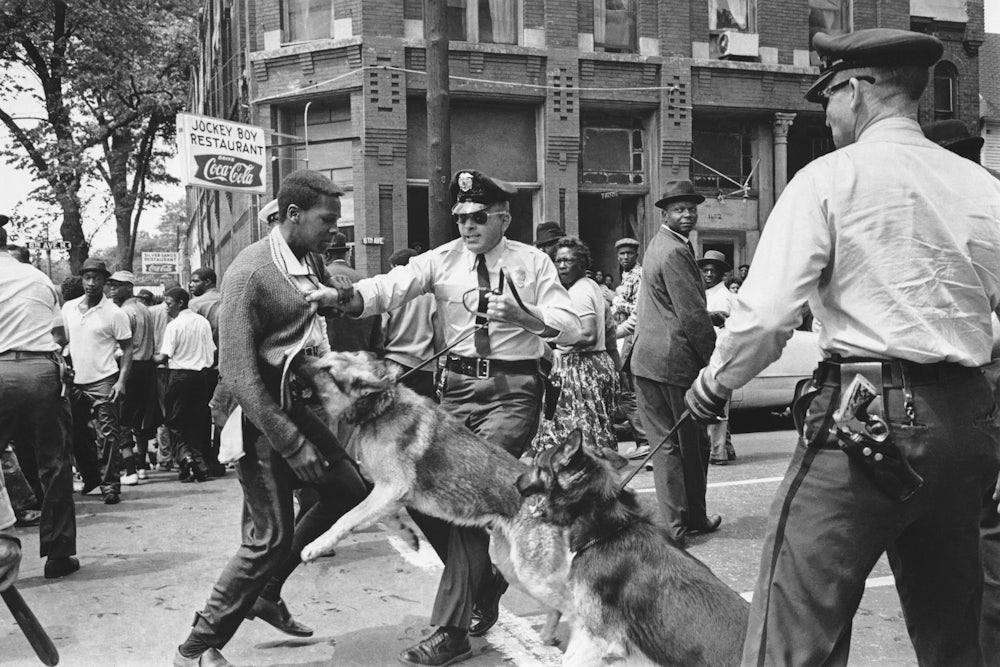The shooting in Alexandria, Virginia, which wounded House Majority Whip Steve Scalise and four others on Wednesday, has roused worrywart pundits and politicians who fret about the state of America today. “The United States is in a time of great danger,” John Podhoretz wrote in The New York Post. “I don’t want to invoke all the clichés of the past decade, but you know them all—we’re a divided nation, we’re all living in our own bubbles, we don’t even accept the same facts and we hate each other. The problem is these clichés are largely true.” There is a real danger, he argued, that America is entering an era of political violence like the one that began with JFK’s assassination in 1963, “reached an apogee in 1968, and came to an end with the nearly successful attempt on Ronald Reagan in 1981.”
In less alarmist terms than Podhoretz, House Minority Leader Nancy Pelosi also claimed that our era is characterized by particularly intense vitriol. “It didn’t used to be this way,” Pelosi said on Thursday. “Somewhere in the ’90s, Republicans decided on the politics of personal destruction as they went after the Clintons.”
The notion that Americans are particularly angry today has become a rote talking point in the political press, repeated year after year. In 2011, after Representative Gabby Giffords was shot by a mentally ill man, NBC’s Mark Murray wrote, “If one word summed up the past two years in American politics, it was this: anger.” In 2007, George Will wrote in The Washington Post, “Americans are infatuated with anger.” In 1996, in her book The Angry American, George Washington University political scientist Susan Tolchin described an epidemic of “voter rage.”
But long before any of these writers, amid Barry Goldwater’s demogogic presidential campaign, the great historian Richard Hofstadter began his classic 1964 essay “The Paranoid Style in American Politics” thus: “American politics has often been an arena for angry minds. In recent years we have seen angry minds at work mainly among extreme right-wingers... But behind this I believe there is a style of mind that is far from new and that is not necessarily right-wing. I call it the paranoid style simply because no other word adequately evokes the sense of heated exaggeration, suspiciousness, and conspiratorial fantasy that I have in mind.”
Hofstadter was exactly right—not only about the anger in the mid-’60s, but also that it was “far from new.” We are not, as Podhoretz and Pelosi suggest, living in a especially or uniquely dangerous moment. Incendiary political speech and political violence have been pervasive in U.S. history.
“What is impressive to one who begins to learn about American violence is its extraordinary frequency, its sheer commonplaceness in our history, its persistence into very recent and contemporary times, and its rather abrupt contrast without our pretensions to singular national virtue,” Hofstadter wrote in the introduction to American Violence: A Documentary History, the 1972 collection he co-edited with Michael Wallace. It shouldn’t surprise us that a colonial settler society that wiped out the Native American population, imported slave labor, and relied on vigilante violence to police newly incorporated territories should be prone to political violence. Reading through Hofstadter and Wallace’s book, one is reminded anew that American history has consisted of slave revolts and their violent crushing, race riots, labor clashes, and assassinations.
There have always been loud voices in the press egging on this violence. At the end of the nineteenth century and the beginning of the twentieth, newspapers run by William Randolph Hearst were notorious for their incendiary content. In 1900, Hearst columnist Ambrose Bierce wrote a poem hoping that the bullet that killed Kentucky Governor William Goebel would also murder President William McKinley: “The bullet that pierced Goebel’s breast / Can not be found in all the West; / Good reason, it is speeding here / To stretch McKinley on his bier.” McKinley was assassinated the following year, leading another Hearst writer, Arthur Brisbane, to write in an unsigned editorial, “If bad institutions and bad men can be got rid of only by killing, then the killing must be done.” This appeared not in some small-town rag, but The New York Journal, one of the most popular newspapers in America at that time.
Westbrook Pegler was one of the most popular conservative pundits of mid-twentieth century America—the Rush Limbaugh of his time. In 1933, he wrote a column regretting that an assassination attempt against President Franklin Roosevelt “hit the wrong man” and killed the mayor of Chicago instead. In 1950, Pegler argued that “the only sensible and courageous way to deal with Communists in our midst is to make membership in Communist organizations or covert subsidies a capital offence and shoot or otherwise put to death all persons convicted as such.” This would have resulted in a political purge killing tends of thousands of Americans. In 1965, when Pegler was admittedly in sharp decline and had lost much of his popularity, he wrote that he hoped “some white patriot of the Southern tier will spatter [Robert Kennedy’s] spoonful of brains in public premises before the snow flies.”
The words of Bierce, Brisbane and Pegler should cure us of the illusion that American political discourse was ever more polite and less violent than it is now. Similarly, recalling the political violence woven throughout the fabric of American history should serve as an antidote to any misguided nostalgia for a supposedly more idyllic past. If America is polarized and violent now, it’s because it has long been that way. The divisions of the present are part of the nation’s patrimony.
